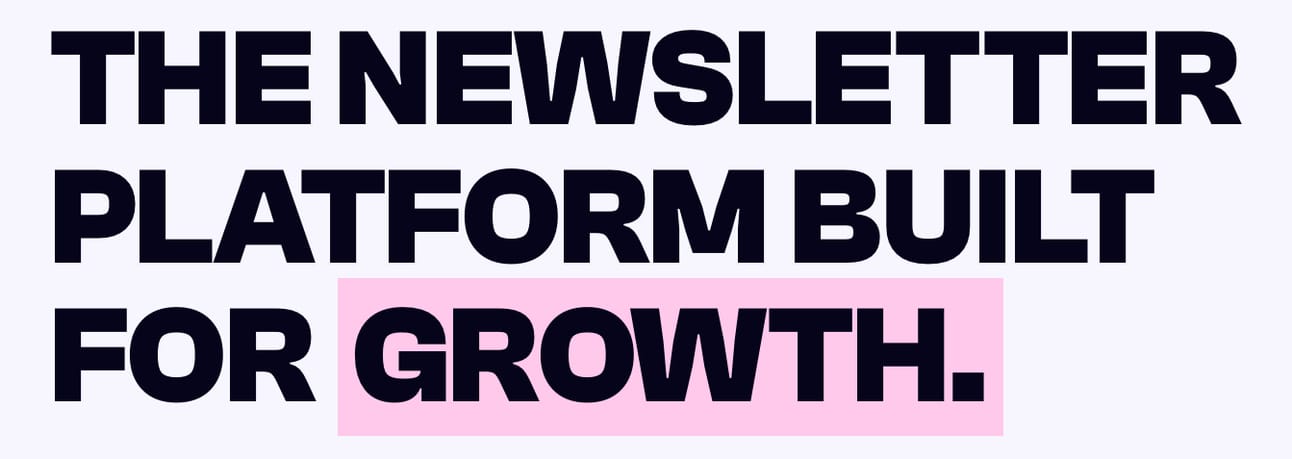Hey, Grow Newsie reader!
Getting your ad pricing right isn't just about maximizing revenue—it's about building sustainable relationships with advertisers while maintaining your audience's trust. Price too high, and you'll struggle to find sponsors. Price too low, and you're leaving money on the table while potentially devaluing your newsletter in the market.
We're diving deep into one of the most crucial aspects of newsletter monetization: pricing your ads effectively.
The Foundation: Understanding Your Newsletter's Value
Before setting any prices, you need to understand what makes your newsletter valuable to advertisers:
Audience Quality Over Quantity: A highly engaged audience of 5,000 subscribers in a specific niche often commands higher rates than a broad audience of 50,000. Advertisers pay for attention and action, not just eyeballs.
Engagement Metrics That Matter: Track your open rates, click-through rates, and most importantly, your click-to-conversion rates for previous sponsors. These numbers become your pricing ammunition.
Niche Authority: Newsletters in specialized industries (B2B SaaS, fintech, healthcare) typically command premium rates compared to general interest publications.
Primary Pricing Models Explained
1. CPM (Cost Per Mille) Pricing
This is the most common model where you charge per 1,000 subscribers.
Industry Benchmarks:
General newsletters: $5-15 CPM
Business/Tech newsletters: $15-40 CPM
Highly specialized niches: $40-100+ CPM
When to use: Best for newsletters with large, engaged audiences and consistent growth.
2. Flat Rate Sponsorships
A fixed price regardless of subscriber count, based on placement and exclusivity.
Typical ranges:
Primary sponsor (top placement): $500-5,000+
Secondary placement: $200-1,500
Classified/job board listings: $50-300
When to use: Ideal for newsletters with highly engaged, niche audiences where advertisers value the association more than reach.
3. Performance-Based Pricing
Charging based on clicks, conversions, or specific actions taken.
Common structures:
Cost per click (CPC): $0.50-5.00
Cost per acquisition (CPA): 10-30% of advertiser's customer value
Revenue sharing: 20-50% of generated sales
When to use: Best when you have strong conversion data and want to align with advertiser success.
The Complete Pricing Formula
Here's a practical approach to calculate your baseline rates:
Step 1: Calculate Your Effective Reach
Total subscribers × Average open rate = Effective reach
Example: 10,000 subscribers × 35% open rate = 3,500 effective reach
Step 2: Research Your Market
Identify 3-5 similar newsletters in your space
Check their media kits or reach out for pricing
Use tools like SparkToro to understand audience value
Step 3: Apply the Value Multiplier Start with industry CPM benchmarks, then adjust based on:
Above-average engagement rates: +20-50%
Highly specialized audience: +50-100%
Proven conversion history: +30-70%
Premium newsletter design/brand: +10-30%
Advanced Pricing Strategies
Tiered Sponsorship Packages
Create multiple options to capture different advertiser budgets:
Platinum Package ($X,XXX)
Primary placement
Custom creative collaboration
Social media amplification
Newsletter mention in 2 consecutive issues
Gold Package ($XXX)
Secondary placement
Standard ad format
Analytics report
Silver Package ($XX)
Brief mention or classified listing
Perfect for smaller budgets or testing
Seasonal and Dynamic Pricing
Adjust your rates based on:
High-demand periods: Increase rates 20-30% during peak seasons for your niche
Subscriber growth phases: Gradually increase rates as your audience grows
Advertiser urgency: Premium pricing for last-minute requests
Common Pricing Mistakes to Avoid
Underpricing from the start: It's easier to start higher and negotiate down than to raise prices later. Many successful newsletter creators say they wish they'd started with higher rates.
Ignoring your costs: Factor in the time for ad creation, communication, reporting, and the opportunity cost of the ad space.
Not tracking performance: Without data on how ads perform in your newsletter, you can't justify premium pricing or improve results for sponsors.
Pricing based on desperation: If you need the money badly, you're more likely to accept lowball offers. Build a pipeline of potential sponsors so you can negotiate from strength.
Creating Your Media Kit
A professional media kit justifies your pricing and makes the buying process easier:
Essential elements:
Subscriber count and growth trajectory
Demographics and psychographics
Engagement metrics (open rates, click rates)
Testimonials from previous sponsors
Clear pricing and package options
Sample newsletter screenshots
Case studies with specific results
Negotiation Best Practices
Start with your rate card: Always present your standard pricing first. This anchors the negotiation at your preferred price point.
Bundle for value: Instead of just discounting, add value through additional placements, extended campaigns, or bonus features.
Know when to walk away: Not every sponsor is worth having. Low-paying sponsors can damage your ability to charge premium rates to future partners.
Get payment terms upfront: Net-30 is standard, but push for Net-15 or even payment upon booking when possible.
Pricing for Long-term Success
Remember that your pricing strategy should evolve with your newsletter's growth:
Months 1-6: Focus on building case studies and testimonials, even if that means accepting slightly lower rates Months 6-12: Gradually increase rates based on proven performance and growing audience Year 2+: Command premium rates based on your track record and market position
The most successful newsletter creators view their first year of sponsorships as building their pricing foundation for years of premium revenue ahead.
Action Items for This Week
Audit your current metrics: Calculate your effective reach and engagement rates
Research competitor pricing: Identify 3 similar newsletters and estimate their rates
Create your baseline pricing: Use the formula above to set your starting rates
Draft your media kit: Even a simple one-page version will help you appear more professional
Identify 10 potential sponsors: Start building relationships before you need them
What's your biggest challenge with newsletter pricing?
Keep growing!
With love,
Nikhil
How was today's edition?
If you’ve ever thought about starting your own newsletter (or switching to a better platform), I’ve partnered with the beehiiv team to set you up with:
✅ 20% off your first 3 months
✅ A free 30-day trial, no credit card needed
